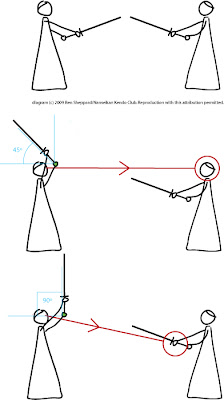Book review: "Kendo Tokuhon: the Kendo Reader" by Noma Hisashi (McCall edition)
What a difficult book to review, there's so much I could say. My two word review would be, "Buy it."* But I will try to add a little about why I think you should.
Kendo Tokuhon: The Kendo Reader is a wonderful little book: only 120-some pages and not much in the way of practical explanations of technique. There are some chapters on the different waza, and a brief description of each. These are more like an inventory than a how-to manual however. Noma doesn't bother to describe such things in too much detail. Instead he tries to cover broadly and briefly all the main elements of Kendo. It's a bold undertaking but he succeeds remarkably well. From starting with "Why study Kendo?" he progresses to basics like "Clothing and Appearance" and "How to hold the sword". These chapters are as enlightening to experienced kenshi as much as they are for beginners. Later chapters cover more subtle concepts, such as "Kyojitsu" (Truth and Falsehood), "Hinkaku" (Dignity of Character) and "Sen" (Initiative). These are definitely aimed at those who have been training for a while.
Noma at left
Those knowledgeable about Kendo can see some of the subtle historical differences in his descriptions of even simple things as compared with how they are considered today. In fact Noma's book provides a bridge between classical Kendo and modern Kendo. For instance in the chapter on "Kamae", Noma explains that the positions of chudan no kamae and seigan are basically the same. Seigan is a term that was widely used in classical Kendo but is less known today, and Noma helpfully provides the three different ways of spelling it in Japanese. He also mentions that hasso no kamae is also known as in no kamae, and waki gamae as yo no kamae. In (陰) and yo (陽) are the Japanese readings of the Chinese terms yin and yang. Such details can open up new understanding when one starts his or her own investigation into the history of Japanese swordsmanship.
For me this is the greatest value of the book: the fact that Noma was writing at a time that was a cross-roads between a Kendo that still had links to killing, and Kendo that was purely for self-development. He was well-trained and intelligent enough to encompass both. Reading this book is like listening to an old 8th dan Hanshi speak about Kendo. Through it we learn about and keep alive knowledge that has been hard-won by generations past.
Noma fighting in the Tenranjiai (on left)
Beginners, especially children, often ask me very direct questions, like "Why is there so much shouting in Kendo?" I try to answer my best but often find that I haven't thought adequately about it. It's just something we do! Of course this is not a good answer, and I wish I had Noma's list in mind when last I was asked.
Kakegoe (use of the voice in Kendo) causes the following:
- It stimulates the spirit;
- It focuses one's resources upon a single point, thereby producing greater than normal power;
- It makes the enemy aware of one's power and spirit;
- It forestalls the enemy's intentions;
- It confuses the enemy;
- It lures the enemy in;
- It irritates the enemy;
- It startles the enemy;
- It declares one's victory.
He then quotes Musashi's ideas on the use of the voice in classical swordsmanship (including battlefield use) and how this relates to modern Kendo. Like Musashi, Noma often ends a paragraph with the recommendation to the reader, "This requires careful study."
This edition and its genesis are well detailed on George McCall's site. From my point of view as a reader I found the square format of the book attractive, and the design of the book clear, stylish and to-the-point. There are only a few typos, which are difficult to completely eradicate in a self-publised book. I know George and I know how much work he would have put into making sure all his translations were checked and double-checked against various sources, to make sure the nuance of a particular phrase was transmitted accurately. This is not translation work that can be done by anyone. It requires a thorough knowledge not just of Japanese but of both Kendo and classical sword traditions, and the anachronistic, specialist terminology employed in both. George has immersed himself in Japanese sword culture deeply in his more than 10 years living in Japan and has translated many smaller works in that time. "The Kendo Reader" is his magum opus as a translator.
A couple of minor quibbles would be with some large spelling mistakes up front: "Content" instead of "Contents" (a result of George's IT background perhaps? hehe!) and "Forward" instead of "Foreword". Also, after several reads, the closeness of the text to the edges of the pages becomes a bit claustrophobic. But again, for a self-published book these details are minor. And being an online book, there is ample scope for fixes along the way.
Overall the book gives the reader a great deal to look at, read, and think about. I especially love the inlays with calligraphy by Noma and some of his teachers. This translation is the work of someone who loves Kendo and who wants to share the very best information he can find with the non-Japanese-speaking world. Indeed you could say that is the mission statement of the whole kenshi247 site.
I could go on and on with excerpts of my favourite bits, but for all my students, don't worry, I'll be quoting them at you over the next few months!
Buy it here.
*Although, as I said above, I know George, I purchased this book myself for full price and did not receive any inducement to review it.

Comments